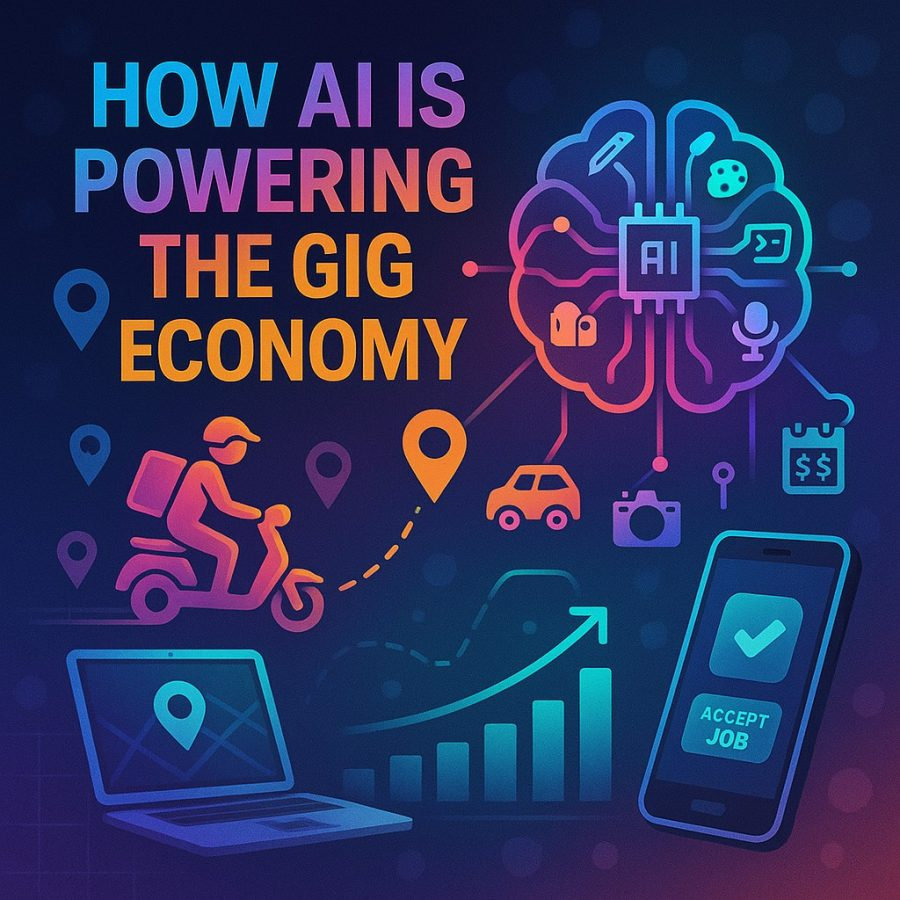Views: 0
The gig economy is no longer just about side hustles or weekend freelancing. It is a global workforce reshaped by algorithms, apps, and platforms that connect people to opportunities in seconds. But what truly fuels this transformation?
The answer lies in artificial intelligence. This How AI Is Powering the Gig Economy article explores the invisible digital engine that matches drivers with riders, freelancers with clients, and delivery workers with hungry customers.
We will peel back the curtain on how AI optimizes platforms, influences workers’ pay, designs customer experiences, and even shapes the very definition of modern work. Along the way, we will highlight the benefits, risks, and realities of relying on machine intelligence to run an economy built on temporary contracts and flexible labor.
The Gig Economy Defined
Before diving into AI’s role, let us define the gig economy. It refers to a labor market built on short-term, task-based work rather than traditional full-time employment. Drivers for Uber, designers on Fiverr, delivery workers for DoorDash, and virtual assistants on Upwork all belong to this ecosystem.
The appeal? Flexibility for workers and efficiency for clients. The catch? Stability and protections often fall short. This is where AI comes in, because without intelligent systems to manage supply, demand, and trust, the gig economy would collapse under its own weight.
How AI Is Powering the Gig Economy: Matching Supply and Demand
The most obvious way AI drives the gig economy is through matching. Algorithms analyze massive amounts of data in real time to connect workers with tasks.
Ride-Hailing: AI predicts where demand for rides will spike and positions drivers accordingly.
Freelance Platforms: Machine learning pairs client job postings with freelancers who have the right skills and ratings.
Delivery Apps: AI calculates the fastest routes for drivers, factoring in traffic, weather, and even restaurant prep times.
Without these predictive and adaptive systems, users would face endless delays, and workers would waste hours chasing jobs.
Pricing: The Algorithm Decides
In the gig economy, pricing is rarely static. AI sets rates dynamically.
Surge Pricing: In ride-hailing, AI raises prices during high demand, incentivizing drivers to work and ensuring customers willing to pay more can get rides quickly.
Task Bidding: On platforms like Upwork, AI highlights competitive price ranges for projects based on skill levels and market rates.
Delivery Costs: AI determines delivery fees by analyzing distance, driver availability, and estimated drop-off times.
This intelligent pricing maximizes profits for platforms while balancing worker supply and consumer demand. However, it also sparks debates about fairness, since workers often have little visibility into how rates are calculated.
How AI Shapes Worker Experience
The gig economy worker’s experience is not just managed by human supervisors but by AI itself. Apps act as both boss and co-pilot.
Ratings and Reviews: Algorithms calculate worker reputations based on customer feedback, influencing future job opportunities.
Performance Monitoring: AI flags late deliveries, low ratings, or canceled gigs.
Gamification: Platforms use AI to design incentives, such as “complete three more deliveries in the next hour for a bonus.”
Workers often describe this as being “managed by an app,” where AI nudges behavior without human intervention.
Customer Experience Driven by AI
For customers, AI ensures seamless convenience.
Personalized Recommendations: Freelance platforms suggest specific workers based on prior hires.
Order Predictions: Food delivery apps predict when you are likely to reorder and suggest meals.
Fraud Prevention: AI detects unusual patterns, protecting both buyers and sellers from scams.
In essence, AI creates the illusion of magic that pressing a button instantly gets you what you want. Behind the scenes, however, it is sophisticated prediction at work.
AI in Logistics: The Hidden Backbone
Gig economy platforms do not just coordinate people; they coordinate logistics. AI optimizes the flow of goods and services.
- Route Optimization: Delivery apps use AI to choose the fastest, most fuel-efficient paths.
- Inventory Predictions: Retail gig platforms forecast which products will be in demand, ensuring stock levels.
- Time Estimates: AI calculates when your package or food will arrive, often more accurately than humans could manage.
Logistics is where AI flexes its muscles. The scale of delivery networks would be impossible without machine optimization.
Training and Upskilling With AI
Workers in the gig economy often need new skills to stay competitive. AI plays a role here too.
- Skill Recommendations: Freelance platforms use algorithms to suggest new certifications or courses based on market demand.
- Automated Training: Chatbots and AI-driven tutorials coach workers on how to improve performance.
- Predictive Insights: Platforms forecast emerging trends, nudging workers to acquire relevant skills early.
This creates a cycle where AI not only manages existing work but also directs workers toward future opportunities.
Global Reach Through AI Translation
The gig economy is global, and AI translation tools make cross-border collaboration possible.
- Instant Communication: Freelancers can chat with clients in different languages with minimal friction.
- Localized Interfaces: Platforms adapt listings for different regions.
- Cultural Context Awareness: AI-powered systems are becoming better at understanding idioms, reducing miscommunication.
This expansion makes the gig economy accessible to workers in emerging markets, broadening opportunities worldwide.
The Dark Side: Risks and Criticisms
No How AI Is Powering the Gig Economy article would be complete without tackling the risks.
- Algorithmic Control: Workers often feel powerless under opaque AI rules that determine job availability and pay.
- Bias: AI may reinforce discrimination if trained on biased data. Ratings systems can unfairly penalize certain groups.
- Job Precarity: AI efficiency sometimes drives wages down, as platforms prioritize customer satisfaction over worker earnings.
- Privacy: Apps track location, behavior, and performance constantly, raising surveillance concerns.
- Mental Health: The stress of gamified incentives and performance ratings can affect worker well-being.
AI is powerful, but its use in the gig economy has sparked debates about fairness, transparency, and ethics.
Governments and AI Regulation in the Gig Economy
Governments worldwide are catching up to regulate how AI is used in gig platforms.
- Transparency Laws: Some regions require companies to explain how algorithms decide pay and opportunities.
- Worker Protections: Regulations in Europe push for gig workers to be classified as employees if apps control too much of their work.
- AI Accountability: Legislators demand audits of algorithms to ensure they do not discriminate.
The tension lies between protecting workers and preserving the efficiency that makes gig platforms viable.
Success Stories: AI Empowering Workers
Despite the risks, AI does provide meaningful benefits when used responsibly.
- Flexible Income: Workers can log in and out of apps at will, thanks to AI managing demand.
- Expanded Reach: Freelancers gain clients globally through AI matching.
- Time Savings: Delivery drivers benefit from optimized routes that reduce wasted hours.
- Opportunities for All: AI reduces barriers by giving entry-level workers access to gigs without traditional hiring hurdles.
The promise of AI in the gig economy is not just about corporate profit but about democratizing work.
Case Studies
Ride-Hailing Platforms
Uber and Lyft rely heavily on AI. Their systems predict where demand will rise, balance driver supply, and optimize trip pricing. Without AI, rides would take longer and cost more.
Freelance Marketplaces
Upwork and Fiverr use AI to analyze job postings and freelancer profiles, surfacing the best matches. This ensures clients find skilled workers faster and freelancers get opportunities aligned with their expertise.
Food Delivery Apps
DoorDash and Deliveroo use AI to estimate delivery times, assign drivers, and even predict popular menu items. AI creates a smooth dining experience that keeps customers loyal.
How AI Shapes the Future of the Gig Economy
Looking ahead, AI will continue to reshape gig work in several ways:
- Autonomous Vehicles: Driverless cars could transform ride-hailing.
- Drone Deliveries: AI-guided drones may replace some food or parcel delivery jobs.
- Advanced Freelance Matching: AI could assess work portfolios in more detail, ensuring even more accurate job matches.
- Wellness AI: Future platforms may incorporate mental health monitoring, nudging workers toward healthier habits.
These developments could make the gig economy more efficient but also more disruptive.
Balancing Human and Machine Power
The future of gig work is not about machines replacing people, but about machines managing people. This is where balance is critical.
AI is excellent at coordination, prediction, and optimization. Humans excel at creativity, empathy, and improvisation. A sustainable gig economy must combine both.
Pros and Cons of AI in the Gig Economy
| Pros | Cons |
| Faster matching of workers to tasks | Lack of transparency in pay and rules |
| Optimized logistics saves time and costs | Surveillance and privacy concerns |
| Personalized customer experiences | Worker precarity and instability |
| Global reach through translation | Risk of algorithmic bias |
| Flexible income opportunities | Potential for downward pressure on wages |
Conclusion: The Real Answer
So, How AI Is Powering the Gig Economy is by acting as the invisible infrastructure that makes it possible. AI manages logistics, sets prices, matches workers, and ensures customers are satisfied. Without it, the entire system would grind to a halt.
But the story is not entirely positive. While AI brings convenience and flexibility, it also creates risks: opaque control, bias, and worker exploitation. The challenge now is to harness AI’s power responsibly, with transparency, fair wages, and protections for workers who depend on it.
The gig economy is not going away, and neither is AI. Together, they will continue shaping how millions of people work, earn, and live. The question is not whether AI powers the gig economy it is how we ensure that power benefits everyone, not just the platforms.



